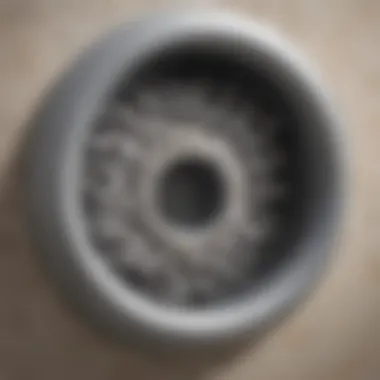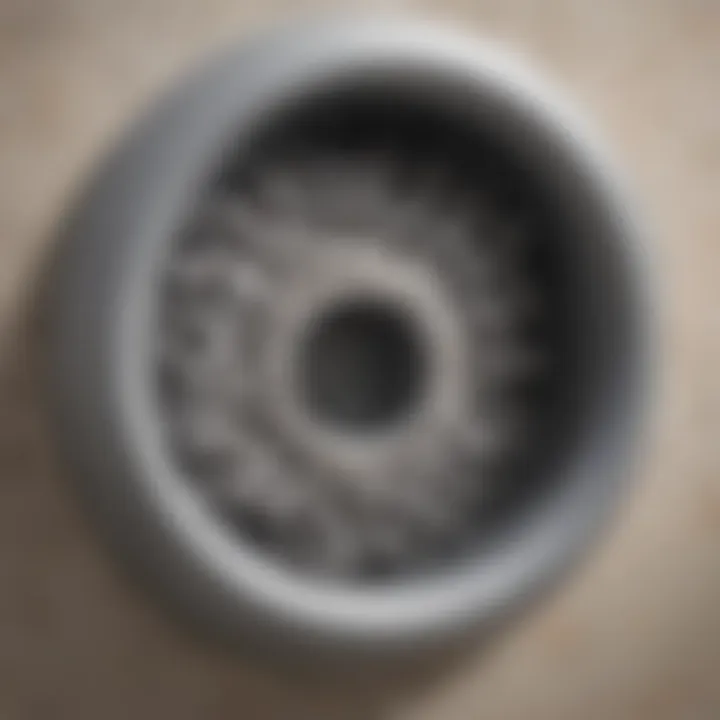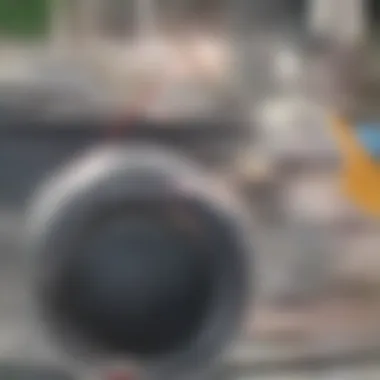Essential Steps to Effectively Clean Your Dryer Vents


Intro
Maintaining dryer vents is essential for optimal appliance performance and home safety. Many homeowners overlook this task, not understanding the risks associated with lint buildup. This comprehensive guide aims to shed light on the importance of regular cleaning, the methods to effectively remove lint, and the potential hazards resulting from neglecting this vital maintenance chore.
Dust, lint, and debris accumulate over time within dryer vents, leading to obstructed airflow. Poor airflow can cause dryers to work harder, which increases energy consumption. In extreme cases, accumulated lint is a significant fire hazard. As such, understanding how to clean and maintain these vents is key for homeowners.
This guide reveals the best practices for cleaning dryer vents, details on conducting the cleaning process, and when to consider hiring a professional service. Knowing how to keep your dryer vent clear will not only enhance efficiency but also promote safety in your home.
Prolusion to Dryer Vents
Dryer vents play a crucial role in the operation of household dryers. They serve as the pathway through which the moisture-laden air exits the dryer. Understanding their function and maintenance is essential for ensuring both safety and efficiency in every laundry cycle. A clean dryer vent can prevent serious issues such as fire hazards and inefficient drying.
Definition of Dryer Vents
Dryer vents are duct systems specifically designed to allow hot, moist air generated by the dryer to escape to the outside of a home. They are typically made from metal or rigid plastic and should be straight and short to minimize airflow resistance. Properly designed vents lead to the outside environment, directly removing air that contains lint and other particles created during the drying process.
The Role of Dryer Vents in Home Appliances
Dryer vents are significant for maintaining the dryer’s operational efficiency. When vents become blocked, lint accumulation increases the heat levels in the dryer and reduces the airflow needed for drying clothes effectively. This can lead to:
- Increased Energy Costs: A blocked vent forces the dryer to work harder, consuming more electricity.
- Longer Drying Times: Clothes may remain wet even after a full drying cycle, requiring additional time in the dryer.
- Reduced Appliance Lifespan: Constant strain on the dryer can lead to premature wear and tear.
Keeping dryer vents clean is not just about ease; it is about enhancing safety and performance in the home. This foundational understanding of dryer vents sets the stage for exploring why lint accumulation, maintenance, and cleaning are vital.
Understanding Lint and Its Accumulation
Understanding lint and its accumulation is paramount in maintaining dryer vents. Lint can lead to serious performance issues and pose safety dangers in homes. It directly affects the efficiency of dryers, and knowing what lint is and how it collects can help homeowners address this problem effectively.
What is Lint?
Lint consists of small fibers and particles that shed from clothing and textiles during the drying process. These fibers can originate from various materials, including cotton, wool, and synthetic fabrics. The dryer drum’s tumbling action, combined with the heat, dislodges these fibers, causing them to mix with the air and moisture within the dryer.
The collected lint can appear as fuzzy clumps, often found in the lint trap. However, a significant portion of lint bypasses the trap and travels into the vent system. This accumulation not only reduces drying efficiency but can also create a buildup that leads to blockages.
How Lint Accumulates in Dryer Vents
Lint accumulation in dryer vents occurs through several stages:
- Initial Shedding: During the drying cycle, small particles are released from the fabric. This is the first step in the formation of lint.
- Travel Through the System: Once released, these particles can get caught in the dryer’s internal mechanisms or be sucked through the venting system. Depending on vent design and airflow, lint may not all be trapped or filtered effectively.
- Settling and Buildup: Over time, the combination of heat and moisture causes loose lint to settle within the vent. This settling creates blockages that restrict airflow.
Factors that contribute to lint accumulation include:
- Length of Vent: Longer vents tend to allow more lint to settle.
- Sharp Turns: Bends or kinks within the vent system can catch lint, preventing it from being expelled from the dryer.
- Vent Material: Rigid metal ducts are preferable as they allow for smoother airflow compared to flexible plastic or vinyl ducts, which can trap lint more easily.
In summary, understanding lint and how it accumulates is essential for preventing dryer issues. Regular maintenance can mitigate these risks, ensuring efficiency and safety.
"A clean dryer vent is vital for optimal performance and safety in the home."
By staying informed about lint and its behavior within dryer vents, homeowners are better equipped to manage their appliance's health and function.
Consequences of Neglected Dryer Vent Maintenance
Neglecting dryer vent maintenance can lead to serious consequences that affect the safety, efficiency, and longevity of your appliance. This section covers the vital aspects of why it is essential to prioritize regular upkeep of dryer vents. The implications of inadequate maintenance extend beyond mere inconvenience; they can pose risks to personal safety and incur unnecessary costs.
Increased Risk of Fire Hazards
One of the most alarming consequences of ignored dryer vents is the heightened risk of fire. Lint is highly flammable, and when it accumulates in the vent, it can block airflow. This obstruction causes the dryer to overheat. According to the National Fire Protection Association, failure to clean dryer vents is a leading cause of home fires. The risks are significant, especially in homes where dryers are often in use.
Homeowners must recognize the signs of lint buildup early. If the dryer is excessively hot to the touch or if clothing takes longer than normal to dry, these can be indicators of a clogged vent. In the most severe cases, a fire can ignite from the excessive heat, resulting in catastrophic damage.


"Regular dryer vent cleaning is not just maintenance; it is a critical safety measure for every home."
Reduced Drying Efficiency
Another consequence of neglected dryer vent maintenance is reduced drying efficiency. When lint builds up, air cannot circulate properly. This results in longer drying times and increased energy usage. A dryer working harder means higher utility bills and more wear and tear on the machine, which leads to a decrease in efficiency.
Some common impacts of reduced drying efficiency include:
- Increased energy costs: The more time your clothes spend in the dryer, the more electricity or gas is used.
- Damaged fabrics: Clothes that are exposed to excessive heat may wear out quicker, leading to more frequent replacements.
- Inconvenience: Waiting for clothes to dry longer than necessary can disrupt daily schedules.
Shortened Appliance Lifespan
Finally, neglecting dryer vent maintenance can significantly shorten the lifespan of your appliances. Dryers are complex machines that require optimal conditions to function effectively. Blockages from lint accumulation force the dryer to work harder than intended, which leads to greater mechanical stress.
The implications of this stress can include:
- Increased repair costs: Frequent breakdowns can lead to costly repairs.
- Need for replacement: A dryer that deteriorates prematurely due to lint buildup may need to be replaced years earlier than a well-maintained system.
In summary, understanding the consequences of neglected dryer vent maintenance is crucial. Not only does it pose serious safety risks, but it also impacts the efficiency and longevity of the appliance. Homeowners who take proactive measures can ensure their dryers operate safely and effectively.
Assessing the Need for Cleaning
Assessing the need for cleaning dryer vents is a critical component of maintaining efficient home appliances. Understanding when and why to clean these vents can prevent numerous issues, most notably fire hazards and efficiency loss. This section outlines the key indicators that a dryer vent is clogged, alongside guidelines on how frequently one should conduct cleaning.
Signs of Clogged Dryer Vents
Identifying signs of clogged dryer vents can help homeowners take prompt action before serious problems arise. Key indicators to look out for include:
- Long Drying Times: If clothes are taking longer than usual to dry, it could signal that lint is obstructing airflow. A functioning dryer should dry clothes efficiently.
- Overheating: If the dryer becomes notably hot to the touch during operation, this may be an indication of excessive lint buildup, restricting necessary airflow.
- Burning Smell: Detecting a burning odor while the dryer is running can point to overheating components, often a result of lint accumulation.
- Excess Lint Accumulation: Frequent lint buildup in the lint trap is also a sign of a problem. If there’s an unexpected increase in lint outside of the trap, investigate deeper into the ductwork.
- Increased Indoor Humidity: A dryer that cannot expel moisture efficiently can elevate humidity in the home, creating an uncomfortable environment.
These signs may present themselves at once or may develop over time. Regularly monitoring these indicators can ensure that you catch potential problems before they escalate.
How Often Should Dryer Vents Be Cleaned?
The frequency of dryer vent cleaning can vary based on several factors such as usage and type of dryer. However, general recommendations suggest:
- At least Once a Year: For a household that uses the dryer frequently, an annual cleaning is typically advisable. This practice can prevent lint from building up to hazardous levels.
- Every Six Months: Homes with large families or frequent use may benefit from a semi-annual cleaning. In such cases, lint buildup can occur more rapidly.
- Post Major Renovations or Long Vacations: Consider cleaning after significant home projects or extended periods when the dryer was not used. Dust and debris can settle and enter the vent system during these times.
Each situation requires individualized consideration, and monitoring the signs mentioned earlier can help delegate when a cleaning might be necessary. By paying attention to these factors, you can safeguard appliances and maintain an efficient system.
Tools Required for Cleaning Dryer Vents
Cleaning dryer vents is essential for maintaining efficiency and safety in your laundry space. Having the right tools makes this task easier and ensures thorough cleaning. Proper equipment can make a big difference in the removal of lint and other blockages that may accumulate over time. In this section, we will discuss both basic and optional advanced tools that are beneficial for effective cleaning.
Basic Tools for DIY Cleaning
When cleaning dryer vents yourself, some basic tools are necessary. These tools are usually readily available in most homes or can be easily acquired from local hardware stores. Here are a few important tools you will need:
- Screwdriver: To unfasten and reattach the vent cover. A Phillips head or flathead screwdriver may be required generally.
- Lint brush: A flexible lint brush can reach deep into the vent to remove lint buildup that a vacuum might miss.
- Vacuum cleaner with hose attachment: This is perhaps the most important tool, as it effectively removes lint and debris from the duct.
- Flashlight: Good visibility is crucial. A flashlight helps you see dark areas inside the vent, making cleaning more efficient.
By using these basic tools, you can perform a basic cleaning of your dryer vent and mitigate common issues related to lint buildup.
Optional Advanced Tools
While basic tools suffice for minor cleaning, there are advanced tools available that can enhance your cleaning process. Investing in more specialized equipment can save future headaches caused by clogged vents. Here is a list of some optional advanced tools you might consider:
- Drill with a vent brush attachment: This is very helpful for mechanical cleaning of longer duct runs. It aids in removing stubborn lint quickly.
- Rotary dryer vent cleaning system: This includes a set of flexible rods that connect to your drill, allowing deeper reach into the vent system for intensive cleaning.
- Inspection camera: An inspection camera can help you identify locations of severe blockages within the ductwork. Visibility into the vent's condition ensures you know when additional cleaning is necessary.
- Blower or air compressor: These tools can blow out any debris or loosened lint from the duct, providing a cost-effective air blast method for cleaning.
Utilizing these tools can significantly improve the cleaning process. However, it is important to have a clear understanding of your specific dryer vent setup to select the best tools.
"Regular cleaning of your dryer vent can prolong the life of your appliance and enhance home safety."


In the next sections, we will discuss the step-by-step procedure to clean dryer vents efficiently, drawing on the tools mentioned here.
Step-by-Step Guide to Cleaning Dryer Vents
Cleaning dryer vents is essential for maintaining efficiency and safety in your home. A thorough understanding of the cleaning process enables homeowners not only to reduce fire hazards but also enhance the performance of their dryers. Proper lint removal ensures that drying times are minimized, saving energy and prolonging the life of the appliance. In this guide, we will detail the various steps necessary for effective dryer vent cleaning, focusing on preparation, procedures, and safety.
Preparation and Safety Precautions
Before diving into the cleaning process, consider necessary preparations. First, gather all tools required for the task. Most cleaning jobs will need a vacuum cleaner with a long hose, a dryer vent brush, and possibly a screwdriver. Also, adopt safety precautions seriously. Always unplug the dryer before starting any maintenance to avoid electrical hazards. Further, ensure the workspace is clear of clutter to facilitate movement.
Below is a quick checklist for preparation:
- Tools gathered: vacuum cleaner, dryer vent brush, flashlight
- Clear the area: ensure workspace is organized
- Safety gear: wear gloves and a mask if necessary
Taking these initial steps will help in ensuring that the cleaning is done effectively and safely.
Disconnecting the Dryer
The next step is to disconnect the dryer from the power source and vent system. Unplugging the dryer is crucial for safety reasons. A twist or pull might suffice, but check to see if there's a circuit breaker, too. Once disconnected, carefully move the dryer away from the wall to access the vent.
Be cautious of how far you plug in the dryer again. Ensuring that you have sufficient length on the power cord helps avoid future issues. Also, if the dryer is gas-operated, take care to turn off the gas supply before proceeding.
Cleaning the Lint Trap
Before addressing the vent itself, it is vital to clean the lint trap. The lint trap is a mesh screen located inside the dryer's door. Frequent cleaning prevents lint from building up inside the appliance. To clean the trap, simply pull it out and remove visible lint by hand. A brush or even a vacuum attachment can assist in clearing any stubborn debris.
It’s recommended to clean this trap before every use to maximize airflow and efficiency. This is a simple step that many overlook, leading to much bigger cleaning needs in the future.
Vacuuming the Vent
Once the dryer is disconnected and the lint trap is cleaned, turn your attention to the vent itself. Using a vacuum cleaner with a long hose attachment, vacuum both ends of the vent. Start from the dryer and then reach into the wall vent.
If your vacuum has a brush attachment, use it to brush away settled lint. Take your time during this step as a proper vacuuming job will significantly affect the airflow.
Inspecting for Usual Blockages
After vacuuming, inspect the vent for blockages. Use a flashlight to look for any visible lint or debris that may be stuck. If the vent is flexible, it can be examined more easily. Also, check any bends in the duct where lint may have accumulated.
In some cases, blockages may be deep within, necessitating the use of a dryer vent brush or other specialized tools. If you notice excessive buildup or a very long run, it could indicate that a professional service is needed.
Remember: Regular maintenance is key. Ignoring the cleaning can lead to long-term issues with dryer efficiency and safety.
Through these steps, you can ensure that your dryer vents remain clean and functional. Following this guide will empower you to take control of your dryer maintenance, ultimately enhancing safety and performance.
When to Seek Professional Help
Maintaining your dryer vents is essential for ensuring they run effectively and safely. While many homeowners can manage basic cleaning tasks themselves, there are times when enlisting the aid of professionals becomes necessary. Understanding when to seek professional help can save you time, effort, and possibly prevent hazardous situations.
Indicators for Professional Services
There are several clear signs that indicate it may be time to contact a professional service for dryer vent cleaning. Recognizing these signs early can help mitigate potential hazards:
- Excessive lint buildup: If you notice that lint collects rapidly even after cleaning, it could indicate a deeper obstruction.
- Poor drying performance: If clothes do not dry completely after a standard cycle, airflow issues may exist in the vent.
- Unusual smells: A burning smell or any strange odor emanating from the dryer can indicate overheating, possibly due to lint accumulation.
- Vent pipes that feel hot: After using the dryer, if the vent pipes feel unusually warm, this can signify restricted airflow, which may need professional evaluation.
- Increased drying times: If your dryer is taking significantly longer than usual to dry clothes, this is often a sign of a clogged vent.
Choosing a Qualified Technician
Finding the right technician to handle dryer vent cleaning can make a significant difference in the quality of the service you receive. Here are some key factors to consider:
- Credentials and Certifications: Look for professionals who are certified by organizations such as the National Air Duct Cleaners Association (NADCA). These certifications indicate that they adhere to industry standards.
- Experience and Reputation: Seek technicians who have established experience in dryer vent cleaning. Reading reviews and testimonials can provide insight into their reliability and service quality.
- Insurance: Ensure that the technician carries liability insurance and worker’s compensation. This protects you in case of damages or accidents during the service.
- Transparent Pricing: Request a detailed estimate before the work begins. Avoid technicians who provide vague or unclear pricing structures.
- Follow-Up Services: Some companies offer follow-up visits or maintenance plans. This can be beneficial for ongoing dryer vent health.


"Regular professional maintenance can extend the life of your dryer and also increase safety by preventing fire hazards."
Preventative Measures for Dryer Vent Maintenance
Preventative measures for dryer vent maintenance are crucial for ensuring both safety and efficiency in home laundry operations. By implementing a proactive approach, homeowners can avoid potential hazards, enhance appliance lifespan, and maintain optimal drying performance. This section explores specific elements surrounding regular inspections and investing in lint guards.
Regular Inspection Schedules
Establishing a regular inspection schedule for dryer vents is key to preventing lint buildup and potential fire hazards. Conducting these inspections allows you to identify early warning signs of lint accumulation or other issues that may compromise the dryer’s functionality.
Homeowners should consider checking their dryer vents at least twice a year. This frequency can be adjusted based on usage and overall household activity. For instance, households that utilize dryers more frequently or those with pets may benefit from more frequent inspections.
During inspections, look for signs such as:
- Excessive lint buildup outside the vent opening
- Warmer-than-usual dryer surfaces during operation
- Longer drying times than normal
By routinely examining these aspects, one can proactively address issues before they escalate, aiding in laundry efficiency. Incorporating professional maintenance services every couple of years can also help identify hidden problems, ensuring complete safety and effective performance.
Investing in Lint Guards
Investing in lint guards is another effective preventative measure for maintaining dryer vents. Lint guards are devices that help capture lint before it enters the vent system, reducing the likelihood of clogs. These guards can significantly lessen the volume of lint that builds up in the vent, promoting safer dryer operation.
There are several types of lint guards available on the market. Some options include:
- Screen-enclosed guards: These fit on the exterior vent cap and prevent debris from entering while allowing airflow.
- Inline lint traps: These are installed within the vent system, providing an additional layer of lint capture before the air exhausts outside.
"Preventing lint accumulation is simpler and far more efficient than dealing with aftermath of neglect."
Using these guards not only enhances safety by minimizing fire risks but also extends the life of your dryer by reducing strain on its components. The long-term cost-savings from using lint guards often outweigh the initial investment, making them a sound decision for any homeowner.
Sustainable Practices Related to Dryer Use
In the context of modern home management, sustainable practices related to dryer use are essential for maximizing both energy efficiency and environmental responsibility. Homeowners are becoming increasingly aware of the long-term implications of their choices. This section will highlight the critical elements and benefits of adopting sustainable practices when utilizing dryers while also addressing important considerations.
By implementing these practices, users not only optimize their appliances' performance but also contribute to broader environmental goals. The need for sustainable dryer use resonates with anyone concerned about resource consumption and ecological impact. Thus, understanding the ramifications of habitual practices about dryer use is integral.
Energy Efficiency Considerations
Recognizing energy-efficient methods when using dryers can lead to substantial savings on utility bills and reduced carbon footprints. Here are some energy efficiency considerations:
- Load Size: Always try to run full loads. Running smaller, half-filled loads can waste energy. Opting for larger loads minimizes the number of cycles needed.
- Dryer Settings: Utilize appropriate settings, such as moisture sensing technology, to determine when clothes are dry. This prevents over-drying and conserves energy.
- Regular Maintenance: Clean the lint trap and dryer vents regularly. A well-maintained dryer operates more efficiently and minimizes energy consumption.
- Ventilation: Ensure proper ventilation and airflow. Blocked vents can cause the dryer to work harder than necessary, using more energy.
Implementing these simple yet effective strategies can significantly influence energy consumption.
Eco-Friendly Dryer Sheets and Alternatives
Many consumers rely on traditional dryer sheets for fresh scents and static reduction. However, these products may contain chemicals harmful to both the environment and personal health. Using eco-friendly dryer sheets or alternative solutions can positively impact the ecological footprint. Below are some safer options:
- Reusable Dryer Balls: These are made from wool or silicone and help separate laundry, improving air circulation. They can reduce drying time and static without chemicals.
- Vinegar: Adding vinegar to the rinse cycle can prevent static cling and soften clothes naturally.
- Essential Oils: A few drops of essential oils can be added to dryer balls or cloths for a natural scent while staying eco-friendly.
- Homemade Dryer Sheets: Soaked fabric squares in a mixture of vinegar and water act as chemical-free dryer sheets.
Each alternative not only provides effective results but also minimizes the introduction of synthetic materials and toxins into the environment. By prioritizing these sustainable practices, homeowners can enhance their laundry routines while taking proactive steps towards environmental conservation.
Summary
Cleaning lint out of dryer vents is an essential aspect of home maintenance that should not be overlooked. Frequent buildup of lint can lead to significant problems, including fire hazards and decreased efficiency of your dryer. In this article, we emphasize the relevance of regular cleaning practices to safeguard your home and improve appliance performance.
By maintaining clean dryer vents, homeowners can ensure better airflow, reducing drying times and energy consumption. This leads to both cost savings on utility bills and a longer lifespan for the appliance.
Moreover, understanding how to properly clean dryer vents can empower individuals to take control of their appliance maintenance. This empowers them to reduce reliance on professionals, while still knowing when it is crucial to contact experts.
"Regular maintenance can save you from expensive repairs and enhance your home's safety."
Therefore, this article serves as a comprehensive resource, equipping readers with knowledge and strategies to effectively handle lint buildup in their dryer vents.
Key Takeaways
- Lint Accumulation: Regular cleaning prevents lint from accumulating, which poses risks like fires and inefficient drying.
- Cost Efficiency: A well-maintained dryer vent can lead to lower energy bills due to reduced drying times.
- Appliance Longevity: Proper care extends the life of the dryer, reducing the need for replacements and repairs.
- DIY vs Professional: Homeowners should learn the basic cleaning methods but know when to seek professional assistance for in-depth cleaning.







